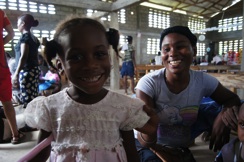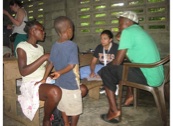SHADA: An extremely poor area in Cap-Haitien. The garbage-filled landscape there is peppered with crude shacks, unclothed children dirty from the mud, and mothers whose eyes have been robbed of any hope. Shada literally means misery in Creole, which is an unfortunate description of the slum. Hands Up for Haiti and their partners could not rest knowing that people are living among a garbage landfill, so together, we made some big changes:
Nothing was more emotional than when Judy and I toured the new Shada clinic. For those who have been there before the difference was striking. Thanks to efforts of Dr. Ted Kaplan of the Cap Haitien Health Network, pressure was put on USAID, and the sewage and
sludge has been removed from the area in front of the clinic and almost to the bridge. A wall and canal were built to keep the worst of it away from the area where the children live and play. The clinic has been completely rebuilt by SOIL with donated funds from Hands Up For Haiti. New roof, tiled floor, benches for the people an exam room and a pharmacy. There is electricity and SOIL will soon install a new toilet. The people of Shada are VERY grateful to Hands Up For Haiti and for all the help we are giving them.




































